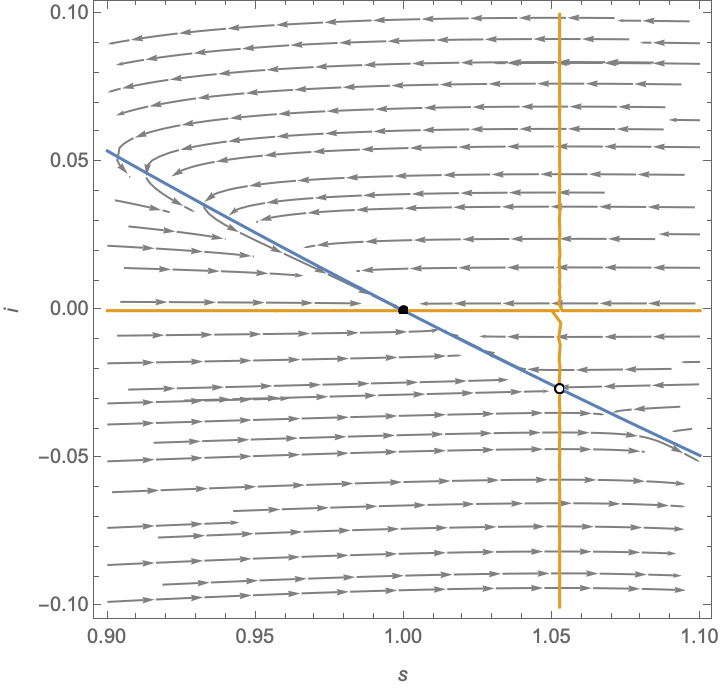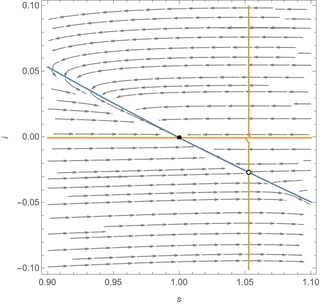Let's go straight to the phase planes using PlotEcoPhasePlane, manually adding the total population constraint as a pink straight line. The subcriticalno-disease case (disease-free equilibrium eq[[1]] is stable, the other equilibrium eq[[2]] is biologically meaningless since s > n and i < 0):
β = 0.95; γ = 1; n = 1;
Show[
PlotEcoPhasePlane[{s, 0.9, 1.1}, {i, -0.1, 10.1}],
Plot[n - s, {s, 0.9, 1.1}, PlotStyle -> Pink],
RuleListPlot[{{s -> n, i -> 0}, {s -> (n \[Gamma])/\[Beta], i -> n - (n \[Gamma])/\[Beta]}}, PlotMarkers -> {True, False}]
]


and the supercriticalendemic case (endemic equilibrium eq[[2]] is stable):
β\[Beta] = 4; γ\[Gamma] = 1; n = 1;
Show[
PlotEcoPhasePlane[{s, 0, 1}, {i, 0, 1}],
Plot[n - s, {s, 0, n}, PlotStyle -> Pink],
RuleListPlot[{{s -> n, i -> 0}, {s -> (n \[Gamma])/\[Beta], i -> n - (n \[Gamma])/\[Beta]}}, PlotMarkers -> {False, True}]
]


Again, because of the total-population constraint, this is effectively a one-dimensional system with either two or one feasible (non-negative) equilibria. Note that the two different isoclines ($S$ and $I$) overlap completely because of this and just look gold.
On to the phase planes. The $S$-isocline is blue, to which I will include the equilibria (probably should automate this...)$I$-isocline is gold.
SubcriticalNo-disease case (eq[1] is stable, eq[2] is a biologically meaningless saddle point):
β\[Beta] = 0.95; γ\[Gamma] = 1; ξ\[Xi] = 1; n = 1;
eq = SolveEcoEq[];SolveEcoEq[]
N[EcoEigenvalues[eq[[2]]]]
Show[
PlotEcoPhasePlane[{s, 0.9, 1.1}, {i, -0.1, 10.1}],
RuleListPlot[eq, PlotMarkers -> EcoStableQ[eq]]
]
(* {{s -> 1., i -> 0}, {s -> 1.05263, i -> -0.0263158}} *)
(* {-1.02384, 0.0488359} *)


SupercriticalEndemic case 1 (stableeq[2] is a stable focus, due to complex eigenvalues):
β = 4; γ = 1; ξ = 1; n = 1;
eq = SolveEcoEq[];SolveEcoEq[]
N[EcoEigenvalues[eq[[-1]]]]N[EcoEigenvalues[eq[[2]]]]
Show[
PlotEcoPhasePlane[{s, 0, 1.1}, {i, 0, 1.1}],
RuleListPlot[eq, PlotMarkers -> EcoStableQ[eq]]
]
(* {{s -> 1, i -> 0}, {s -> 1/4, i -> 3/8}} *)
(* {-1.25 + 1.19896 I, -1.25 - 1.19896 I} *)
SupercriticalEndemic case 2 (stableeq[2] is a stable node, due to negative real eigenvalues):
β = 4; γ = 1; ξ = 10; n = 1;
eq = SolveEcoEq[];SolveEcoEq[]
N[EcoEigenvalues[eq[[-1]]]]N[EcoEigenvalues[eq[[2]]]]
Show[
PlotEcoPhasePlane[{s, 0, 1.1}, {i, 0, 1.1}],
RuleListPlot[eq, PlotMarkers -> EcoStableQ[eq]]
]
(* {{s -> 1, i -> 0}, {s -> 1/4, i -> 15/22}} *)
(* {-9.60337, -3.1239} *)













